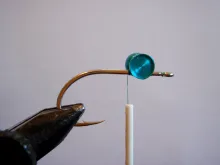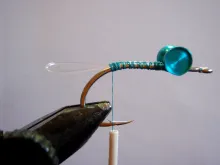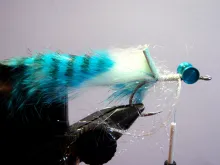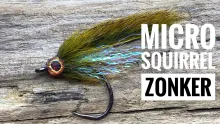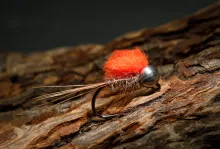This is an impressionistic streamer, tied to match the schooling sardines being eaten by baby tarpon. It has fooled many fish
This colour variation of my Red Mist tarpon fly has proven to be a guide favorite for a variety of species in numerous tropical locations.
Designed as an impressionistic streamer to match the schooling sardines being eaten by Campeche’s baby tarpon this pattern has also fooled tarpon in Roatan, jacks in Cuba, ladyfish in Mexico, trevally in Hawaii and snook in Belize. This fly will also work in freshwater for northern pike, bull trout and peacock bass.
Tied using a light weight aluminum dumbbell eye the Mist sinks slowly, suspending itself in front of the fish. It is also relatively easy to cast, moves water, which makes it possible for fish to locate the fly in off-coloured water using their lateral lines, and the tail is resistant to fouling around the hook.
All said, this pattern has accounted for some very nice fish.
Tying instructions
|
|
|
|
|
|
|
|
|
|
|
|
|
|
|
|
|
|
Step 1. Insert the hook in the vise. Attach the thread and wrap back two hook eye lengths.
Step 2. Place a drop of Zap-A-Gap Gel on the thread wraps and then firmly figure eight wrap the Sea Eyes to the top of the hook (This fly rides hook point down).
Step 3. Tie in a 6 cm long piece of 20 lb Mason hard mono, on top of the hook, starting at a point directly behind the eyes and wrapping the thread over the mono to a point at the bend of the hook. Form the free end of the mono into a 1 cm loop extending off the bend of the hook. Wrap the thread back up the hook shank securing the mono and locking down the mono loop.
Step 4. Return wrap the thread back down the hook shank stopping at the point opposite the barb of the hook.
Step 5. Cut a 5.5 cm long rabbit strip and trim the hide into a point at the end the hair extends over.
Step 6. Tie in the rabbit strip at the bend of the hook, parting the hair and binding the hide down with 8 firm thread wraps so that a 4 cm long rabbit strip tail extends off the back of the hook.
Step 7. Pushing the short rabbit strip up and out of the way, tie in a piece of polar chenille at the bend of the hook.
Step 8. Using touching wraps, palmer the polar chenille forward to a point behind the eyes. When wrapping the material try and trap as few of the fibres as possible. Tie down the polar chenille and trim away the excess material
Step 9. Pull the short piece of the rabbit strip over the polar chenille body and tie it down behind the eyes.
Step 10. Tie in a piece of body fur behind the eyes and palmer wrap it 3 times to form a back facing collar. Tie down the body fur behind the eyes, trim away the excess material and wrap the thread forward to a point in front of the eyes.
Step 11. Build up a small thread head, whip finish and cover all the exposed thread wraps with UV Clear Fly Finish.
Step 12. Place a drop of Gorilla glue gel into each eye socket and then seat the Fish Skull living eyes.
Your Blue Mist is now complete and you are ready to head out On The Water!
- Log in to post comments



